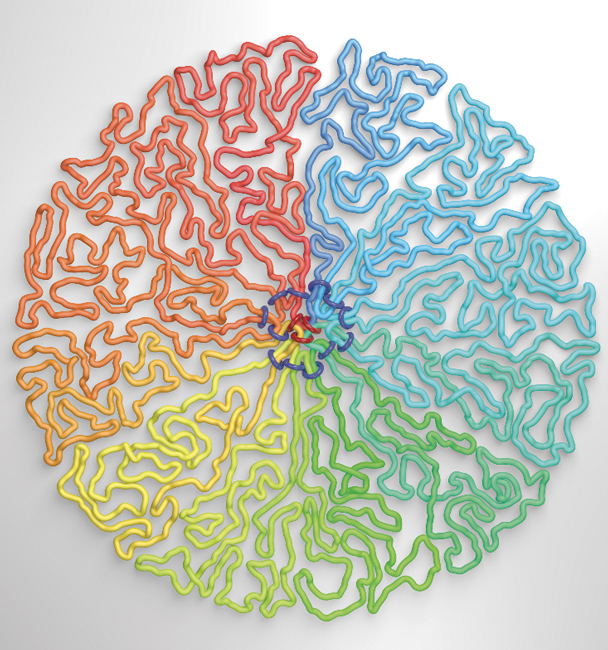
This Article From Issue
May-June 2018
Volume 106, Number 3
Page 141
In this roundup, digital features editor Katie L. Burke summarizes notable recent developments in scientific research, selected from reports compiled in the free electronic newsletter Sigma Xi SmartBrief. Online: https://www.smartbrief.com/sigmaxi/index.jsp
How Chromosomes Form
During cell division, genetic molecules that would measure more than two meters long if fully unfurled are packed into bundles just microns wide. A new study settles a debate about how this feat is accomplished. Some researchers had thought that the packing involves winding the DNA into a spiral, whereas others thought it is condensed as a set of loops. The answer, according to unprecedented imaging, molecular analysis, and computer simulations, turns out to be a bit of both. Two proteins, called condensin I and condensin II, are key to the process. Condensin II forms big loops. Then, condensin I splits the larger loops into smaller ones. Finally, the nested loops wind into a spiral. Most of the packing process, which is fundamental to all living organisms, is achieved within 15 minutes.

Anton Goloborodko & Johan Gibcus et al.
Gibcus, J. H., et al. A pathway for mitotic chromosome formation. Science doi:10.1126/science.aao6135 (January 18)
Translation in Giant Viruses
Translation, the synthesis of proteins from RNA, is a process that distinguishes living cells from viruses. But the discovery of two of the largest viruses ever found—Tupanviruses that are 2.3 micrometers long, or roughly 20 times as long as an HIV virus—has upended this notion. These viruses have unexpectedly comprehensive equipment for building proteins. Each was found an in an extreme environment, one in the deep ocean and the other in a highly alkaline lake in Brazil. The Tupanviruses have much of the machinery for translation seen in cells, except for the ribosome, a molecular complex that links together amino acids to make proteins. Nobody knows whether viruses evolved before or after the earliest cells, and these viruses open up the opportunity to study this fundamental question about life’s evolution.

Springer Nature
Abrahão, J., et al. Tailed giant Tupanvirus possesses the most complete translational apparatus of the known virosphere. Nature Communications 9:749 (February 27)
Crossing the Blood-Brain Barrier
A study in fruit flies shows that more molecules can cross the blood-brain barrier at night than during the day, indicating that drug treatments for some brain diseases could be more successful when administered at certain times. A team led by Amita Sehgal of the University of Pennsylvania injected fruit flies with a fluorescent dye at time points throughout the day, and showed that more dye ended up in the diurnal insects’ brains in the early evening than at other times. When they repeated the protocol in flies lacking a crucial gene to their biological clock function, timing of the injection had no effect. Next, the researchers studied how time of injection affects drug uptake. They fed an antiseizure drug to a strain of epileptic fruit flies. Those that received the drug in the early evening showed faster seizure recovery times than flies that received it in the afternoon. It is unclear how these results might translate to vertebrates. Sehgal’s lab is now studying whether similar results can be obtained in mammals.
Zhang, S. L., Z. Yue, D. M. Arnold, G. Artiushin, and A. Sehgal. A circadian clock in the blood-brain barrier regulates xenobiotic efflux. Cell doi:10.1016/j.cell.2018.02.017 (March 8)
Signature from First Stars
A dip in radio waves from the early universe reveals that the first stars showed up about 180 million years after the Big Bang and that the early universe was much colder than expected. Theory predicts that the first stars formed from neutral hydrogen gas that permeated the universe. Once those stars started shining, their ultraviolet light would have ionized the hydrogen gas surrounding them, a process that would have caused it to absorb cosmic background radiation. Filtering out this absorption signal from other radio waves coming from space has been a challenge, partly because cosmologists didn’t know exactly what frequency to search for, because the signal would have been stretched as the universe expanded. Once a team of astronomers led by Judd Bowman of Arizona State University found the signal at a frequency of 78 megahertz, they then used the rate of cosmic expansion to calculate when the stars appeared. The signal was much stronger than predicted, which indicates that the hydrogen gas was colder than they had thought. One potential explanation for the lower temperature is an interaction with dark matter, mysterious material whose existence has been detected because of its gravitational influence on galaxies. The results still need to be confirmed. If they are, then many areas of research into the early universe and dark matter will open up.

N. R. Fuller/NSF
Bowman, J. D., A. E. E. Rogers, R. A. Monsalve, T. J. Mozdzen, and N. Mahesh. An absorption profile centered at 78 megahertz in the sky–averaged spectrum. Nature 555:67–70 (March 1)
Gap-Filling Dinosaur Fossil
The well-preserved remains of a large, long-necked, plant-eating dinosaur found in the Egyptian desert fills a big gap in the fossil record, which will help answer questions about the last days of the dinosaurs in the late Cretaceous in Africa. The new species, named Mansourasaurus shahinae, lived about 80 million years ago and was about the length of a school bus and the same weight as an elephant—relatively small for the group it belongs to, the Titanosauria, which includes some of the largest land animals to walk the Earth. During the Cretaceous, the land mass Pangaea began to split apart into the continents known today. Because of a lack of African fossils from this time, it has been unclear how much land animals in Africa had diverged from those on other continents. The morphology of M. shahinae suggests that it was more closely related to dinosaurs in Europe and Asia than to those in southern Africa or South America. This finding indicates that some dinosaurs moved between Africa and Europe at this critical juncture in Earth’s history. Paleontologists will now ramp up their search for more specimens in the region.
Sallam, H. M., et al. New Egyptian sauropod reveals Late Cretaceous dinosaur dispersal between Europe and Africa. Nature Ecology & Evolution doi:10.1038/s41559-017-0455-5 (January 29)

American Scientist Comments and Discussion
To discuss our articles or comment on them, please share them and tag American Scientist on social media platforms. Here are links to our profiles on Twitter, Facebook, and LinkedIn.
If we re-share your post, we will moderate comments/discussion following our comments policy.